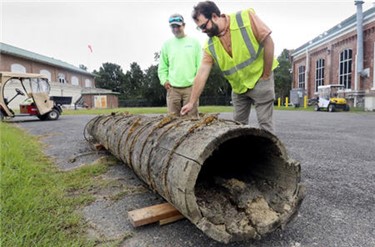Old Wooden Water Infrastructure Discovered

By Sara Jerome,
@sarmje

Water workers in South Carolina recently unearthed a pipe that seemed, by today’s standards, ancient.
“They quickly knew it was really, really old,” The Post & Courier reported.
The 20-inch diameter pipe discovered in Charleston “was made of wood staves held together with metal bands, sort of like a tubular barrel,” the report stated.
It is not the first time water workers have found themselves on something of an archeological dig. For example, utility crews in Maryland unearthed a wooden pipe three years ago that appeared similarly old.
“Long-abandoned wooden pipes left beneath older communities aren’t unheard of, but century-old utility plans typically don’t pinpoint their location and rarely is one ever dug up, utility officials said. Even some veteran WSSC pipe experts had never laid eyes on one. Water utility and infrastructure nerds rejoiced,” The Washington Post reported.
A WSSC spokesperson spoke to The Post at the time. “You just don’t see this very often,” the official said. “This is very, very cool.”
In Charleston this month, the excitement was similar. Water system spokesman Michael Saia described the discovery.
“We knew that wooden pipes were a thing, and we knew we probably had some a long time ago, but no one in our organization had ever seen one,” he said, per the report.
Today’s pipes are usually made of ductile iron in Charleston. In the past, they have been made of cast iron, wood, PVC, steel and high-density polyethylene, the report stated.
“The recent discovery sent the utility’s staff scrambling to their archives; records indicate the wood pipe was installed by 1918,” the report stated, citing Don Benjamin, the utility’s assistant director of engineering and construction.
“Since the utility has been using cast iron pipes as far back as 1879, Benjamin guessed that it might have opted for wooden pipe because of materials shortages during World War I, which ended in 1918. But there’s no firm proof of that,” it continued.
Utility records indicate the pipe was likely taken off line by 1933, the report said.
Wood pipes would leak until the wood swelled, which would keep them watertight. The metal pieces holding the wood together would rust, creating leaks and giving wooden water pipes a relatively short life.
Charleston Water System CEO Kin Hill said the utility plans to display the artifact.
“We’re not sure yet what that entails in terms of time and effort and energy and cost,” Hill stated, “but it really is a piece of our history.”
When a similar finding was made in Newton, NC, this month, that artifact was also put on display.
“We have put sections of the line in the lobby at City Hall and they will remain there until a permanent location is found for them,” Alex Frick, public information officer for City of Newton, told The Hickory Record.
